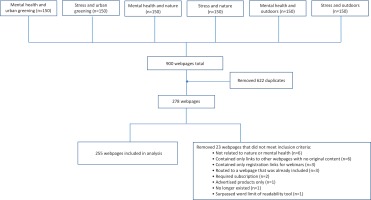INTRODUCTION
Mental illness remains one of the leading causes of disease burden globally1. In the US, 21% of adults experience mental illness each year2. Despite this high prevalence, under half of those with a mental illness will receive mental health services due to factors such as lack of knowledge about effective treatments, shortage of available treatment providers, and stigma associated with seeking treatment2,3. Thus, some may utilize other resources, such as the Internet, to find ways to improve their mental health. For example, recent work found that 33% of adults utilize the Internet to access mental health-related information3.
Research indicates that greater exposure to nature and green spaces is associated with reduced stress, anxiety, and depression4-8, and these protective associations may be sustained long-term9. An examination of the relationship between green space and mental health in a sample of 2479 adults in Wisconsin found that individuals living in neighborhoods with greater green space had 2.19 times fewer odds of stress symptoms and 4.02 times fewer odds of depression symptoms when compared to those living in neighborhoods with fewer green spaces6. Another study of 191 adults in Louisville, Kentucky, assessed the relationship between views of greenness and depression, and found that individual satisfaction with neighborhood greenness was associated with fewer odds of depression (OR=0.42)8. Therefore, increasing exposure to natural environments may be an easy and cost-effective method for improving mental health. These findings received media attention during the early phases of the COVID-19 pandemic when the public was encouraged to spend more time outdoors10-12. As a result, it is possible that many individuals searched online for information about the impact of exposure to nature on mental health.
To be effective, such online information should be written in ways that maximize ease of understanding by the general public. Indeed, the American Medical Association (AMA) recommends that readability of written health-related content should be at or below a 6th grade reading level13. However, a recent review found that the average readability of general online health information in North America was between a 10th and 15th (i.e. high school sophomore to college junior) grade level14. In line with this work, the average readability grade level for online mental health information ranges from 9th to 12th grade15-17. Yet, to the best of our knowledge, the readability of online information related to exposure to nature and mental health has yet to be assessed. Therefore, the purpose of the current study was to determine the average reading level of online information about the potential benefits of nature on mental health.
METHODS
A web search was conducted between 30 August and 9 September 2021, using the following six search terms: ‘mental health and urban greening’, ‘stress and urban greening’, ‘mental health and nature’, ‘stress and nature’, ‘mental health and outdoors’, and ‘stress and outdoors’. The terms reflected what the general public may use to search for information about how being outdoors or in nature and mental health might be related. Three coders conducted independent searches for each search term using the Google search engine in a Google Chrome Incognito browser, which reduced the possibility for search results to be influenced by the coder’s search history.
The first 50 webpages for each search term were recorded by each coder (N=900; 50 webpages × six search terms × three coders). Data from the three coders were combined and duplicate webpages (n=622) were removed. An additional 23 webpages were excluded because they were not related to greenness, nature, stress, outdoors, or mental health (n=6), only contained links to other webpages and had no original content (n=6), only contained registration links for webinars (n=3), routed to a webpage that was already included (n=3), required a subscription to access (n=2), were product advertisements (n=1), no longer existed (n=1), or surpassed the word limit of the readability tool (n=1). The final sample consisted of 255 webpages (Figure 1), which are listed in Supplementary file Table 1.
The Flesch-Kincaid Grade Level [formula = (0.39 × Average Sentence Length) + (11.8 × Average Syllables per Word) - 15.59] of webpages was assessed using the online readability tool, WebFX18. This measure reports the US grade level required to understand text using the average number of words per sentence and the average number of syllables per word19. Scores range from 0 to 18, with scores from 0 to 12 representing kindergarten to 12th grade reading levels, and scores from 13 to 18 representing post-secondary reading levels. Of note, scores are not always integers and scores with fractional components represent grade levels rounded down to the whole number (e.g. a score of 7.8 represents a 7th grade reading level). We calculated the average reading level for the identified webpages and the percentage of webpages that met the AMA-recommended reading level (i.e. ≤6th grade).
Additionally, descriptive analysis assessed the grade level mean scores and standard deviations. Pairwise independent sample t-tests compared mean scores by year published (2020–2021 vs pre-2020) and search results order (first page results vs others). The t-tests were not significant and thus not included. Data were analyzed using SAS version 9.4.
RESULTS
On average, webpages were written at a Flesch-Kincaid Grade Level of 11.95 (SD=2.68), corresponding to an 11th grade reading level. Reading levels ranged from 5.10 to 20.50, and the majority (68%) required reading levels between 9th grade and college sophomore. Only 5 of the 255 webpages (1.96%) met the AMA guidelines (i.e. ≤6th grade).
DISCUSSION
The current study examined the readability of online information related to exposure to nature and mental health. Consistent with previous research15-17, results indicated that nearly all webpages were written at levels above AMA recommendations, which may render them challenging or impossible for many members of the general public to understand. These findings underscore the need for developers of health-related web content to pay particular attention to AMA readability guidelines to facilitate successful dissemination of online mental health-related information. Because increased exposure to nature and green spaces may be an accessible, comparatively low-cost approach to improving mental health for some populations, as well as a consideration for future urban planning, it is important for clear and accurate information to be easily available and interpretable.
Limitations
The current findings need to be considered in the context of the study’s limitations. This analysis examined only readability and did not assess the accuracy of the information contained on the identified webpages. Future studies might include content analyses to determine whether websites provide accurate information. Also, our search yielded only webpages written in English. Given the high prevalence of non-English speaking and bilingual and multilingual US residents20, future research should examine readability of webpages in other languages. Our study used one search engine, albeit the most frequently employed one, and browser; however, the use of different search engines or browsers may provide variability in webpages identified in search results. Finally, our analysis focused on textual content and did not include visual content, such as images or videos. Future studies should consider investigating visual content as well as the interplay between textual and visual content to better understand the quality of health-related information.
CONCLUSIONS
Web developers and content creators would benefit from examining the readability of their content to increase the likelihood that it can be easily interpreted by wide audiences. The current study indicates that online information about mental health benefits from exposure to nature/green spaces needs to be written at a more appropriate level to facilitate widespread understanding.



